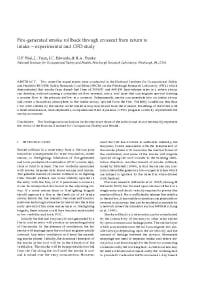Mining Publication: Fire-Generated Smoke Rollback Through Crosscut from Return to Intake - Experimental and CFD Study
Original creation date: June 2006
Authors: GF Friel, L Yuan, JC Edwards, RA Franks
NIOSHTIC2 Number: 20030327
Proceedings of the 11th U.S./North American Mine Ventilation Symposium, University Park, Pennsylvania, June 5-7, 2006. Mutmansky JM, Ramani RV. eds., London, U.K.: Taylor & Francis Group, 2006 Jun; :483-489
Two mine fire experiments were conducted in the NIOSH Pittsburgh Research Laboratory's Safety Research Coal Mine that demonstrated that smoke from diesel-fuel fires of 500- and 660-kW heat-release rates in a return airway can develop, without causing a complete airflow reversal, into a roof layer that can migrate upwind, forming a counterflow to the primary airflow in a crosscut. Subsequently, smoke can penetrate into an intake airway and create a hazardous atmosphere in the intake airway upwind from the fire. Visibility conditions less than 13 m were created by the smoke in the intake airway downwind from the crosscut. Modeling of the event with a three-dimensional, time-dependent, computational fluid dynamics (CFD) program correctly represented the smoke movement.

NIOSHTIC2 Number: 20030327
Proceedings of the 11th U.S./North American Mine Ventilation Symposium, University Park, Pennsylvania, June 5-7, 2006. Mutmansky JM, Ramani RV. eds., London, U.K.: Taylor & Francis Group, 2006 Jun; :483-489
- CFD Analysis of Mine Fire Smoke Spread and Reverse Flow Conditions
- Experimental and Modeling Investigation of the Effect of Ventilation on Smoke Rollback in a Mine Entry
- Experimental and Modeling Investigation of the Effect of Ventilation on Smoke Rollback in a Mine Entry
- How Smoke Hinders Escape from Coal Mine Fires
- Improvement of a Mine Fire Simulation Program � Incorporation of Smoke Rollback into MFIRE 3.0
- Smoke, Carbon Monoxide, and Hydrogen Chloride Production from the Pyrolysis of Conveyor Belting and Brattice Cloth
- Some Relevant Parameters for Assessing Fire Hazards of Combustible Mine Materials Using Laboratory Scale Experiments
- Summary of Combustion Products from Mine Materials: Their Relevance to Mine Fire Detection
- Technology News 497 - "You Are My Sunshine": A New Video Release From NIOSH on the Sunshine Mine Fire
- Technology News 549 - MFIRE 3.0 - NIOSH Brings MFIRE into 21st Century